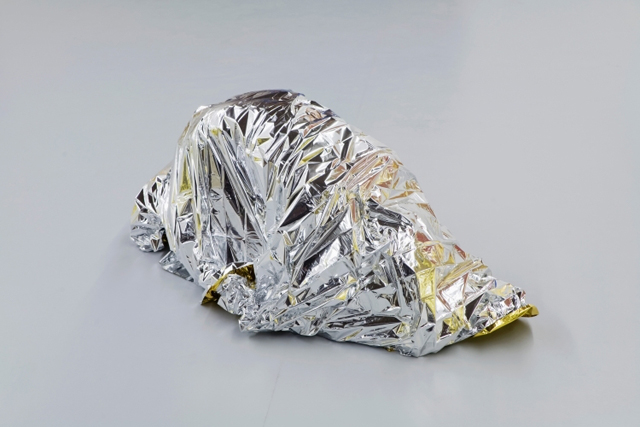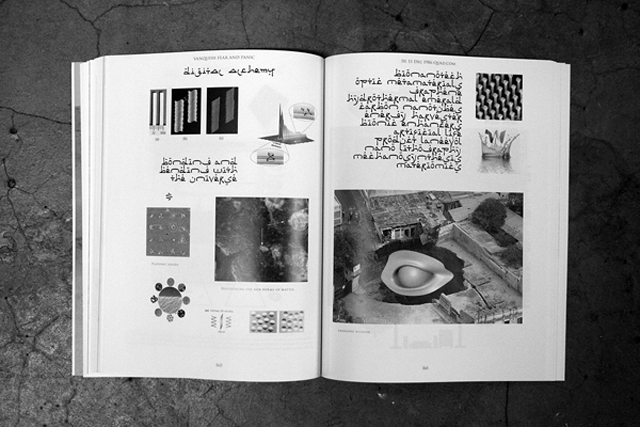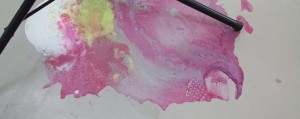A new show at the Friedericianum: Speculations on Anonymous Materials, claims to bring together for the first time, “approaches in international art that reinterpret the Anonymous Materials created by rapid and incisive technological change.” Most of the artists involved work somewhere in the proximity of post-internet art but the exhibition asserts a different connective thread: a shared attitude towards materiality. James Elkins has written about a fear of materiality in art criticism, noting how the physical and material aspects of a work are often explored only so far, while art historical and theoretical accounts dominate. And yet many artists are far less interested in the theoretical paradigms of an hermetically sealed art world than in evaluating the images, objects, media and materials that surround them.
The Speculations on Anonymous Materials exhibition partly appropriates its title from Reza Negarestani’s book Cyclonopedia: Complicity with Anonymous Materials. A work of speculative realism based in the Middle East, the text disrupts any hint of subjective narrative with historical accounts, references and theory. Negarestani’s own anonymous materials take on a life of their own within the text. By focusing on the material aspect, the Speculations exhibition asks us to consider how these artists treat the digital world they interrogate as a world of materials, an interest that exists independent of art historical or conceptual concerns. Here’s a provide of four artists featured, with a view to understanding how materials and materiality are primary concerns among them.

Pamela Rosenkranz’s work bears a direct relationship with Negarestani’s theories -she commissioned him to write a text for her 2009 exhibition in Venice, and shares his interest in Speculative Realism. This young philosophical movement, which grew largely through online dissemination, is based on a rejection of philosophies that privilege the human experience of existence. In much of Rosenkranz’s work, the human body is a felt absence, an entity described by and through objects. In her series, Firm Being (2009), Rosenkranz replaced the clear water in commercial plastic water bottles with skin-toned silicone. An attached Fiji logo continues to sell us its idea of an untouched island paradise while the contents offer only a repellent plastic version of ourselves. In The most important Body of Water is Yours (2010), a stretched spandex surface has been covered in messy gold paint, suggestive of a human imprint. Rosenkranz takes our anthropocentrism to a laughable extreme – we can’t drink our own desires, and we don’t sweat gold. This sentiment reaches a pinnacle in her series Bow Human (2009), where sculptures made from silver emergency blankets hint at human figures cowering underneath. The series warns of dire consequences arising from our human-centered worldview, the same view that makes us assume we really are under the protection of the blanket. Rosenkranz creates a world of independent objects and materials that comment upon our human follies and, she warns, will likely outlive us.

Apocalyptic overtones are also present in the seminal Post Internet Survival Guide (2010), a project and book initiated by Katja Novitskova. The work does not envision the end of the Internet but merely our daily need to cope with it as a given condition. The foreword states; “The notion of a survival guide arises as an answer to a basic human need to cope with increasing complexity. In the face of death, personal attachment and confusion, one has to feel, interpret and index this ocean of signs in order to survive.” But as a random assortment of imagery and text, largely sourced online, the book is less a guide for navigating complexity than a manifestation of it. Surfing the web has become a fairly benign and mundane activity. Most Internet users exploit familiar social media sites as anchorage points for online navigation, never straying far into strange terrain. Works like the Post Internet Survival Guide (2010) re-insert the kind of overwhelming complexity that users seek to avoid, once again rendering the web as a maze of anonymous, unfamiliar materials. The Survival Guide treats online media as a series of independent materials, detached from their origins, functions or meanings.
The films of Ryan Trecartin involve casts of fast-talking characters, often in wigs and face-paint, who shift between different accents in grating high-pitched tones, speaking a kind of pop-culture inspired stream-of-consciousness. Layered upon these loose character narratives is a flow of hyper-coloured computer graphics and post-production effects. Trecartin never allows viewers much time to begin decoding his onslaught of signifiers, combining familiar tropes so frenetically that they blur into a singular hyperactive experience. Text for the Speculations exhibition states that; “The order of the day is to understand the world from the vantage point of abstraction and not to abstract from the world.” This sentiment finds cogency in Trecartin’s work, where his source material, the frenzied world of uploaded videos, is already abstract. As with the Post Internet Survival Guide (2010), his films are not a tool for navigating or understanding the materials they exploit, but a new way of manifesting their frenetic, disjointed and confused existence.
Ed Atkins video work translates the conventions of high-definition film making into unique poetic compositions. Atkins is particularly interested in the slippage between the material and immaterial aspects of the moving image. As digital technology has enabled us to create hyper-real imagery, the physical remnants of film-making have disappeared. Materialist film-makers of the 1960s drew attention to the material nature of film itself, often working directly with film-strips. Despite the lack of a physical substance to manipulate, Atkins evinces similar structural concerns in his work, often imitating traditional camera effects using digital animation. These effects, commonplace in mainstream film-making, are elevated to primary content. An immaterial-material binary pervades all elements of Atkin’s film-making. In Us Dead Talk Love (2012) a floating 3D head speaks a voice-over by Atkins where he recalls finding an eyelash under his foreskin. The visceral and tactile imagery evoked by the dialogue is undercut by the eerie presence of the hyper-realistic yet incorporeal figure. Atkins simultaneously reveals the artifice present in the digital image while re-inserting a sense of the material into his films.
The material aspects of an artwork are often too readily equated with a clear theoretical or art historical meaning. This is especially true of the way we discuss artists working with, or inspired by, digital technology; viewing their interactions as predominantly conceptual, an inevitable consequence of dealing with immaterial media. But for many artists, their interactions with materials are about re-working or re-positioning those materials, not about finitely decoding them. We shouldn’t expect artists to act as our guides into the vast realm of anonymous materials, but to provide pause for visual reflection and speculation. These artists do not adopt the mantle of artist-geniuses carefully manipulating materials to create original artworks, but adopt positions that limit, without erasing, subjective intent, allowing the materials they use to rise to the fore as contingent, independent and anonymous objects.
Header Image: Ed Atkins, ‘Us Dead Talk Love’ (2012).














